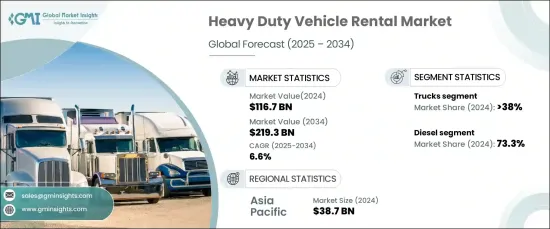
세계의 대형차 렌탈 시장은 2024년에는 1,167억 달러로 평가되었고 2025년부터 2034년까지 연평균 복합 성장률(CAGR) 6.6%를 나타낼 것으로 예측됩니다.
이러한 성장을 가속하는 요인은 차량의 유지보수 및 수리에 있어서 소비자 물가 지수(CPI)의 상승으로, 기업은 보다 비용 효율적인 대안을 찾게 되었습니다. 유지비가 치솟는 가운데 많은 기업들이 차량 대여 서비스를 선택하고 있습니다. 렌탈하면 유지비 상승에 따른 경제적 부담 없이 운송 요구를 충족시킬 수 있기 때문입니다.

대형차 렌탈은 차량 구매에 드는 비용이 많이 드는 초기 비용을 절감하여 기업에 실용적인 솔루션을 제공합니다. 대부분의 경우 임대료가 유지 보수 및 수리를 커버하므로 기업은 예기치 않은 지출을 피할 수 있습니다. 이러한 유연성은 특히 단기 프로젝트 및 계절 수요에 대해 기업이 예산을 최적화하는 데 도움이 됩니다. 대형차 렌탈은 장기적인 투자 없이 필요한 차량을 확보할 수 있기 때문에 재무적으로 현명한 선택이 됩니다. 차량을 구입하는 대신 대여하는 동향 증가는 기업의 재무적 안정성과 업무 효율성 향상을 촉진합니다.
| 시장 범위 | |
|---|---|
| 시작 연도 | 2024 |
| 예측 연도 | 2025-2034년 |
| 시작 금액 | 1,167억 달러 |
| 예측 금액 | 2,193억 달러 |
| CAGR | 6.6% |
시장은 트럭, 버스, 트레일러 및 기타 차량으로 구분됩니다. 트럭 분야가 최대 시장 점유율을 차지하고 2024년에는 38% 이상을 차지했습니다. 이 부문의 성장을 견인하는 것은 신뢰할 수 있고 중단없는 서비스를 보장하는 임대 프로그램의 가용성입니다. 이러한 유연한 대여 옵션은 계절적 수요와 예기치 않은 작업량의 급증과 같은 필요가 변동하는 기업에게 특히 유용합니다. 트럭은 건설, 물류, 광업, 농업 등 수많은 산업에서 중요한 역할을 하고 있으며 대형차 렌탈 시장에 필수적인 존재가 되고 있습니다.
트럭은 원재료, 상품, 기기의 장거리·단거리 수송에 빠뜨릴 수 없기 때문에 높은 수요가 있습니다. 무거운 짐을 다루고 다양한 지형에서 활약할 수 있는 트럭은 다양한 물류 요구를 가진 기업에 필수적인 존재입니다. 대여 트럭은 구매를 대신하는 비용 효율적인 선택이며, 기업은 상당한 초기 투자 없이 보유 대수를 확대할 수 있습니다. 트럭을 대여하는 옵션은 필요에 따라 유연하게 함대를 조정할 수 있으므로 운송 요구 사항이 점차 변화하는 업계에 매력적인 선택입니다.
추진력 유형의 경우 시장에는 디젤, 천연 가스, 전기, 하이브리드 전기 등이 포함됩니다. 2024년 시장에서는 디젤차가 73.3%의 점유율을 차지했습니다. 디젤 차량은 항속 거리가 길고 장거리 주행에 적합하기 때문에 인기가 있습니다. 또한, 디젤 차량은 전기자동차보다 급유 시간이 빠르기 때문에 기업의 가동 중지 시간을 최소화할 수 있습니다. 이러한 요인들로부터 디젤 차량은 다양한 렌탈 요구와 업무 요구에 매력적인 선택이며, 기업에게 항속 거리와 유연성을 모두 제공합니다.
아시아태평양은 대형차 렌탈의 최대 시장이며, 2024년에는 387억 달러를 차지했습니다. 유연한 대여 솔루션에 대한 수요가 이 지역의 성장을 이끌고 있습니다. 아시아태평양의 기업들은 특정 프로젝트와 단기 요건을 위해 차량을 대여하는 것을 선호합니다. 임대 회사는 사용자 정의 가능한 계획을 제공하고 필요할 때 차량을 이용할 수 있으므로 기업은 차량 구매에 투자하지 않고 수요에 따라 사업을 확장 할 수 있습니다.
The Global Heavy Duty Vehicle Rental Market was valued at USD 116.7 billion in 2024 and is projected to grow at a CAGR of 6.6% from 2025 to 2034. This growth is driven by the rising Consumer Price Index (CPI) in vehicle maintenance and repair, which has caused businesses to look for more cost-effective alternatives. As maintenance expenses soar, many companies are opting for vehicle rental services, as renting allows them to meet transportation needs without the financial burden of rising upkeep costs.

Renting heavy-duty vehicles offers businesses a practical solution by eliminating the high upfront costs of purchasing vehicles. With rental fees often covering maintenance and repairs, companies can avoid unexpected expenses. This flexibility helps businesses optimize their budgets, especially for short-term projects or seasonal demands. Renting heavy-duty vehicles provides a financially prudent option, ensuring that companies can access the necessary vehicles without committing to long-term investments. The growing trend of renting vehicles instead of purchasing them is fostering greater financial stability and operational efficiency for businesses.
| Market Scope | |
|---|---|
| Start Year | 2024 |
| Forecast Year | 2025-2034 |
| Start Value | $116.7 Billion |
| Forecast Value | $219.3 Billion |
| CAGR | 6.6% |
The market is segmented into trucks, buses, trailers, and other vehicles. The truck segment holds the largest market share, accounting for over 38% in 2024. This segment's growth is driven by the availability of rental programs that guarantee reliable and uninterrupted service. These flexible rental options are particularly beneficial for businesses with fluctuating needs, such as seasonal demands or unexpected workload surges. Trucks play a critical role across numerous industries, including construction, logistics, mining, and agriculture, making them an essential part of the heavy-duty vehicle rental market.
Trucks are in high demand because they are essential for raw materials, transporting goods, and equipment over both long and short distances. Their ability to handle heavy loads and perform in various terrains makes them indispensable for companies with diverse logistical needs. Renting trucks is a cost-effective alternative to purchasing, as it allows businesses to scale their fleets without the significant upfront capital investment. The option to rent trucks provides companies with the flexibility to adjust their fleets as needed, making it an attractive choice for industries with ever-changing transportation requirements.
Regarding propulsion types, the market includes diesel, natural gas, electric, hybrid electric, and others. Diesel vehicles dominated the market in 2024, holding a 73.3% share. Diesel-powered vehicles are popular because of their extended driving range, making them suitable for long-distance tasks. Additionally, diesel vehicles have faster refueling times than electric options, which helps minimize downtime for businesses. These factors make diesel vehicles an appealing choice for various rental and operational needs, offering businesses both range and flexibility.
The Asia Pacific region is the largest market for heavy-duty vehicle rentals, accounting for USD 38.7 billion in 2024. The demand for flexible rental solutions is driving growth in this region. Businesses in the Asia Pacific prefer renting vehicles for specific projects or short-term requirements, as it allows them to avoid long-term financial commitments. Rental companies offer customizable plans that provide access to vehicles when needed, helping companies scale their operations based on demand without having to invest in purchasing vehicles.